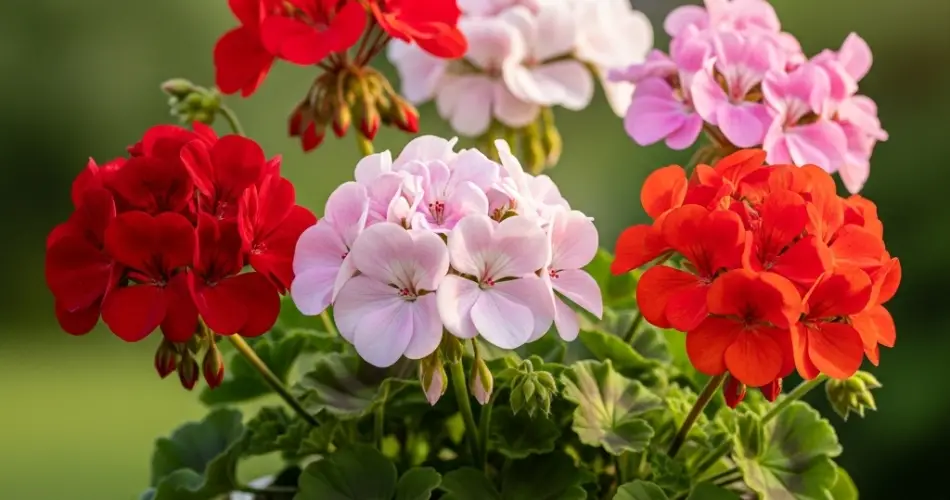Geraniums are among the most beloved garden plants worldwide, renowned for their vibrant, colorful flowers and ease of care. Whether you’re a novice gardener or someone looking to brighten your outdoor space effortlessly, geraniums offer a beautiful solution for year-round blooms. This article will guide you through transforming your garden with geraniums, ensuring vibrant flowers throughout the seasons with minimal effort.
Why Choose Geraniums?
Geraniums (Pelargonium species) stand out for several reasons:
-
Color Variety: Geraniums come in a wide range of colors, from fiery reds and bright pinks to soft whites and purples.
-
Long Blooming Period: With proper care, they can bloom almost year-round.
-
Low Maintenance: They tolerate heat, drought, and many common garden pests.
-
Versatility: Suitable for containers, hanging baskets, borders, and garden beds.
-
Attract Pollinators: Geraniums attract bees and butterflies, boosting your garden’s ecosystem.
These traits make geraniums ideal for gardeners wanting a splash of color without complicated upkeep.
Step 1: Selecting the Right Geranium Variety
There are different types of geraniums, and knowing the right variety for your garden helps ensure success:
-
Zonal Geraniums: The most common type, featuring rounded leaves with dark zones and clusters of flowers.
-
Ivy Geraniums: Known for their trailing habit, perfect for hanging baskets or window boxes.
-
Scented-Leaf Geraniums: Grown primarily for fragrant foliage, though they also bloom.
Choose the variety that best suits your space and aesthetic goals.
Step 2: Preparing the Garden or Containers
Geraniums thrive in well-draining soil and full sun but are adaptable to partial shade.
-
Soil Preparation: Enrich garden soil with organic compost to improve drainage and nutrient content.
-
Containers: Use pots with drainage holes to prevent waterlogging. Use a quality potting mix designed for flowering plants.
-
Location: Pick a spot receiving at least 6 hours of direct sunlight daily to encourage abundant blooms.
Good soil and sunlight are the foundation of vibrant, healthy geraniums.
Step 3: Planting Your Geraniums
Planting at the right depth and spacing is crucial:
-
Spacing: For garden beds, space geraniums about 12 to 18 inches apart to allow airflow and room to grow.
-
Depth: Plant so the base of the stem is level with the soil surface.
-
Watering: After planting, water thoroughly to help settle the soil around the roots.
If planting in containers, avoid crowding to keep plants healthy and vigorous.
Step 4: Watering and Feeding Routine
Geraniums prefer consistent moisture but dislike soggy soil.
-
Watering: Water when the top inch of soil feels dry. Reduce watering in cooler months when growth slows.
-
Avoid Overwatering: Excess water can cause root rot and fungal diseases.
-
Fertilizing: Feed with a balanced, water-soluble fertilizer every 4 to 6 weeks during the growing season to encourage continuous flowering.
Proper watering and feeding promote sustained blooms and lush foliage.
Step 5: Pruning for Continuous Blooms
Regular pruning keeps geraniums healthy and flowering:
-
Deadheading: Remove spent flowers promptly to encourage new blooms.
-
Pinching: Trim leggy growth back to stimulate bushier plants.
-
Seasonal Pruning: Cut back plants in late fall or early spring to refresh and prepare for new growth.
Pruning is an easy habit that dramatically improves your geranium’s appearance and productivity.
Step 6: Protecting Geraniums Through the Seasons
Geraniums are hardy but benefit from seasonal care adjustments:
-
Winter Care: In colder climates, bring potted geraniums indoors or treat them as annuals by planting new ones each spring.
-
Pest Control: Watch for aphids, whiteflies, and spider mites. Use insecticidal soap or neem oil if infestations occur.
-
Disease Prevention: Ensure good airflow and avoid overhead watering to reduce fungal issues.
With seasonal attention, your geraniums can maintain vibrant blooms for much of the year.
Step 7: Creative Uses for Geraniums
Geraniums are versatile and can be used in various ways to enhance your garden:
-
Borders and Edges: Their bright flowers create eye-catching garden borders.
-
Containers and Hanging Baskets: Trailing varieties add vertical interest to balconies and patios.
-
Companion Planting: Geraniums repel certain pests, making them good neighbors for vegetables and herbs.
-
Indoor Decor: Bring cuttings indoors for fresh bouquets or rooting new plants.
Using geraniums creatively maximizes their impact on your garden space.
Troubleshooting Common Issues
Even the easiest plants can face challenges. Here’s how to avoid common geranium problems:
-
Yellow Leaves: Often caused by overwatering or nutrient deficiency.
-
Leggy Growth: Insufficient light or lack of pruning.
-
Pests: Aphids and spider mites can be controlled with regular inspection and natural insecticides.
-
Fungal Diseases: Avoid wet foliage and improve air circulation.
Early intervention helps maintain the health and vibrancy of your plants.
Conclusion
Transforming your garden with geraniums is a rewarding way to add vibrant color and year-round interest without the need for intensive gardening skills. By selecting the right varieties, planting in suitable locations, and following straightforward care routines including watering, feeding, and pruning, you can enjoy continuous, stunning blooms that enliven your outdoor space.
Geraniums’ hardiness, beauty, and versatility make them a perfect choice for gardeners seeking easy yet spectacular results. With these tips, your garden can burst with color and life through every season, turning even a small patch of soil into a vivid floral retreat.



